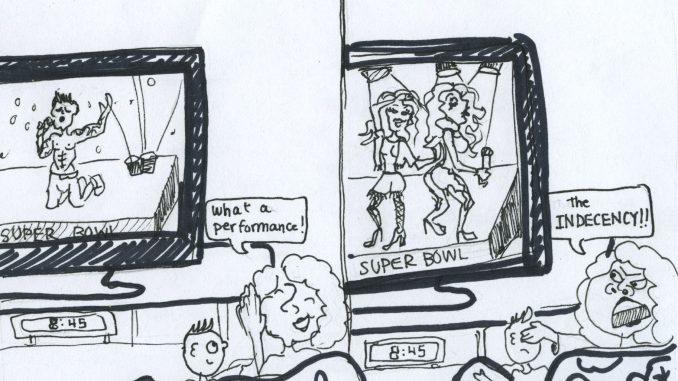
On Sunday night, two of the biggest pop artists of the 2000s — Shakira and Jennifer Lopez — teamed up to headline the Super Bowl LIV halftime show. What was on the surface a celebration of music, dance and Latin culture quickly became the topic of controversy just seconds after the final notes were played inside the Hard Rock Stadium in Miami.
“I am embarrassed for my kids to watch this halftime show,” read one tweet by Twitter user @kevindelong. “No dignity.” Another upset parent, Twitter user @JLMezz, echoed these sentiments. “I’m no prude, but watching it with my 7yo daughter and 11yo son was really uncomfortable,” her tweet read.
Many media outlets also chimed in on the “inappropriate” nature of the performance. Madeline Fry of The Washington Examiner called the show “completely inappropriate for children and the Super Bowl.” She went on to state that “It is the opposite of feminism to teach young girls to look up to icons who act like strippers.”
For USA Today, Gil Smart wrote “If the Super Bowl is going to be touted as family entertainment […] the NFL has an obligation to warn people with children that what they’re about to see may be upsetting to some viewers.”
These criticisms all share some validity in the fact that yes, the Super Bowl is often the most watched television event of the year (this year’s game drew in 105 million viewers) and yes, many of those households have children. However, how much of this shock and anger aimed towards Shakira and J-Lo is really about the nature of their performance?
To answer that question, it’s important to understand why people are so upset in the first place. The most popular aspect of the show cited in criticism is J-Lo’s pole dancing act, a skill the singer learned in preparation for her role in last year’s “Hustlers,” and likely showcased on one of the world’s biggest stages as something of a middle-finger to the Academy Awards for overlooking her for a heavily-predicted nomination.
Criticizing this is only regressive. Pole dancing, which finds its origin in strip clubs and is often given a negative connotation in our culture, is an art form and — in recent years — has become rightfully respected as a form of dance and fitness that takes tremendous skill and strength. Claiming that such an art form has no place at the Super Bowl is shaming a woman for showcasing a skill she spent months learning, just because it may make you personally uncomfortable. Nothing about J-Lo’s pole dancing was overtly sexual, and the only reason one would have to “explain” the dance to their young children would be because they themselves have made it that.
We must also point out the obvious double standards present in criticism of the performance. During the halftime show just last year, when Maroon 5 frontman Adam Levine stripped off his shirt during the band’s performance (revealing more skin than Shakira and J-Lo combined), few parents expressed their concerns with the show being over-sexualized, and criticism of the event focused on the music rather than the male performer’s body.
This year’s show has called into question whether or not Shakira and J-Lo were “objectifying” themselves — the answer to such a question can be found in the simple existence of the term “sexual expression.” It is almost universally agreed upon that at 43 and 50, respectively, Shakira and J-Lo both look great. To shame them for wanting to celebrate this, and to accuse the two of some sort of self-objectification is not only wrong, but completely ridiculous.
Our culture has a long history of shaming women for “sexual” behavior, while praising men for doing the same. Regarding the Super Bowl, one could never forget when Justin Timberlake exposed Janet Jackson’s breast during their 2004 performance, a moment that got Jackson banned from appearing in the halftime show — a show which Timberlake would go on to headline in 2018.
Our culture also has a long history of exoticizing Latina women. In her piece for The Daily Free Press, Maria Jimenez Moya noted how Latina women and aspects of their culture are sexualized, both in the media and in daily life. She explains that the way Latina women are portrayed in popular culture “transfers into the real world, where Latinas feel the obligation to dress explicitly or are expected to do so by white men in order to be accepted in society.”
When applying Moya’s observations to the reaction to this year’s performance, it’s easy to see how hypocritical the response has been. We have cultivated a society where Latina women are sexualized — from the way they talk, to the way the dress, and so on — but the moment they seemingly own that sexuality, it becomes “uncomfortable.”
It’s obvious that the onslaught of anger aimed at Shakira and J-Lo following their performance is caused by several other deep-rooted issues pertaining to women in our culture: the belief that if a woman wears an outfit that isn’t deemed “modest,” she’s asking to be objectified; the belief that if a woman dances in any style other than those that would be appropriate at a Catholic high school’s prom, she’s overly sexual; and the lens through which we view female performers, a much more critical one than that through which we view their male counterparts.
It is only natural for parents to want what’s best for their kids, and that includes protecting them from information or media that may cause them to grow up too fast. But to use children as a vehicle for your own discomfort is more inappropriate than any aspect of Sunday’s performance. This discourse is clearly indicative of a greater problem, one we ask you to examine and solve for the sake of women everywhere.
